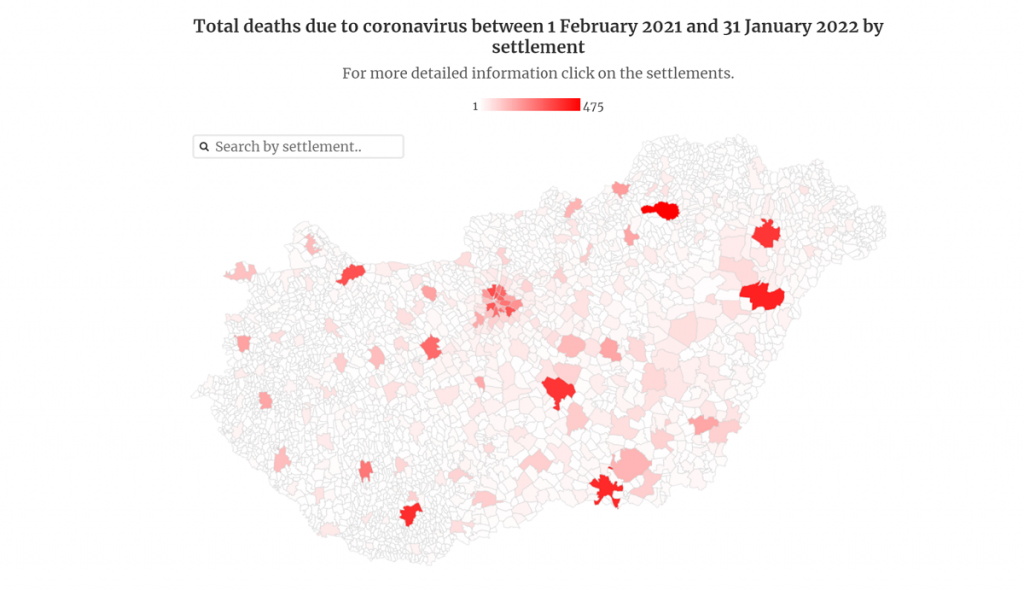The https://english.atlatszo.hu use cookies to track and profile customers such as action tags and pixel tracking on our website to assist our marketing. On our website we use technical, analytical, marketing and preference cookies. These are necessary for our site to work properly and to give us inforamation about how our site is used. See Cookies Policy
Detailed COVID-19 mortality data obtained by Atlatszo raises more questions than it answers
Atlatszo has received more detailed data than ever before from the National Public Health Centre (NNK) on deaths from coronavirus infection. The table shows how many people have died from COVID-19 in a settlement on a given day up to the end of January 2022. However, a comparison with the daily death tolls published on the official coronavirus information website, koronavirus.gov.hu, shows that something is wrong with the data: more than 1600 deaths are missing from the database. In the document we received, we also found a code fragment, which suggests the existence of additional data fields.
As of 18 May, 46 446 people have died from the coronavirus in Hungary. During the previous waves of the pandemic, our country has set several negative records for deaths per 100,000 people worldwide.

We have been trying to obtain detailed data on the evolution of the pandemic for a long time. This time, we wanted to know more about deaths, so at the end of February, we submitted a public interest data request to the National Centre for Public Health (NNK) asking them to send us settlement-level data on daily deaths and daily recoveries (non-cumulative) associated with coronavirus over the past 12 months.
After 90 days of waiting, we finally received settlement-level data for those registered as coronavirus-infected at the time of death between 1 February 2021 and 31 January 2022. However, as they write, the statistics on the cause of death (which is derived from the processing of death certificates) are not held by them. However, the reply shows that they do not have daily data on recovered persons.
The trend in the number of deaths related to the coronavirus is also influenced by the protocol used in a given country, which determines who exactly is considered to have died from COVID. There is no uniform method: most countries follow the WHO recommendation and include deaths likely to be caused by COVID19 in addition to clinically confirmed cases. However, many countries consider a positive test as the relevant test.
In addition, whether someone dies because of the virus or was infected at the time of death is also important. Some countries include all deaths recorded as infected in their mortality statistics. In other countries, only deaths where the fact of infection can be justified as the cause of death are included.
In Hungary, the national protocol includes all deaths from coronavirus in the deaths of those who had tested positive for coronavirus during or before the period of illness. Thus, people who died as a result of some other existing disease but were infected at some time are also included among COVID deaths.
Something is wrong with the data
The table sent by the NNK shows the number of deaths in each settlement (or district of Budapest), broken down by day. We have put the data on a map. This shows where deaths from coronavirus infection were recorded on a given day, but by clicking on a municipality you can also find detailed information on all deaths over a one-year period, broken down by day.
The daily data is aggregated and a map is also provided showing the total number of deaths over the one-year period. This shows that by far the highest number of deaths was in Miskolc (475), followed by Debrecen (414) and Szeged (399). Among the districts of the capital, III, XI, XIII and XVIII stand out, with the number of deaths from the coronavirus exceeding 300 in all three districts.
In Budapest, District V is at the bottom of the list, with only 35 deaths during this year of the epidemic. However, nationally, there are hundreds of typically small villages where only one person has died, according to the NNK.
However, when compared to the regular data releases of the koronavirus.gov.hu (which includes the number of new registered infected, cured, deceased and vaccinated), we see that there are significant differences in the mortality data of the table sent by the NNK.
According to the settlement-level data sent by the NNK, 27,251 people died of coronavirus between February 2021 and the end of January 2022, while the official epidemiological information site reported 28,881 deaths in the same period.
This means that 1,630 deaths are not included in the table now available.
The truth is in the code
The spreadsheet, in addition to containing a table of over 20,000 rows, also contains a separate section called “SQL” with code used for SQL statements. The category names used in each row may all refer to categories that the database on which the statement is based may contain.
In other words, the NNK has a detailed database of deceased persons, including not only the age, sex, disease, address, etc. of the deceased, but also a history of vaccination against coronavirus.
Until we receive a reply to our question to the NNC, we can only speculate as to which data is real: the data previously published daily on koronavirus.gov.hu, or the current figures received through a data request. There is an argument for the validity of both: in addition to the daily mortality figures published on koronavirus.gov.hu, the sex, age and underlying disease of each deceased person are also published, with a serial number. The highest number matches the total number of deaths on each day, so the validity of the daily totals is confirmed by the content of the more detailed list.
The credibility of the data table obtained by the data request is confirmed by the level of detail of the data requested: since we have received the exact figures for each municipality, we can assume that we have a reliable data set. In addition, the SQL statement can also be used as an argument. However, this would not explain why the number of deaths on some days is sometimes more or less than the numbers published on koronavirus.gov.hu, rather than consistently less than each day.
Lack of up-to-date data has long been a problem
This is not the first time that such things happen: we wrote about the lack of transparency of official government communication and the impossibility to obtain up-to-date data on the pandemic many times. We reported that Bernadett Szél independent MP only received data about infected and deceased people in social institutions after several months. Moreover, the settlement-level data of the infected was also published only one year after the beginning of the pandemic, thanks to a Hungarian NGO, K-Monitor. It was also K-Monitor who managed to obtain settlement-level data on deaths in the first year of the pandemic.
We were only able to find out more about detailed vaccination data at municipal level after several unsuccessful data requests. Last week, based on recent data we wrote about exactly how many healthcare facilities have received coronavirus vaccines, and what the national distribution of each vaccine looks like.
Nearly 200 institutions received covid vaccines in Hungary, with significant differences in distribution
We have been trying to obtain data on coronavirus vaccines in Hungary for a long time. In January, we submitted another FOI request to the National Centre for Public Health (NNK), headed by Cecilia Müller, asking for a list of vaccines delivered, by institution.
Translated by Zita Szopkó. The original, more detailed Hungarian version of this story was written by Krisztián Szabó and Zita Szopkó and can be found here.
Hungary. What do you know about Hungary? from atlatszo.hu on Vimeo.


